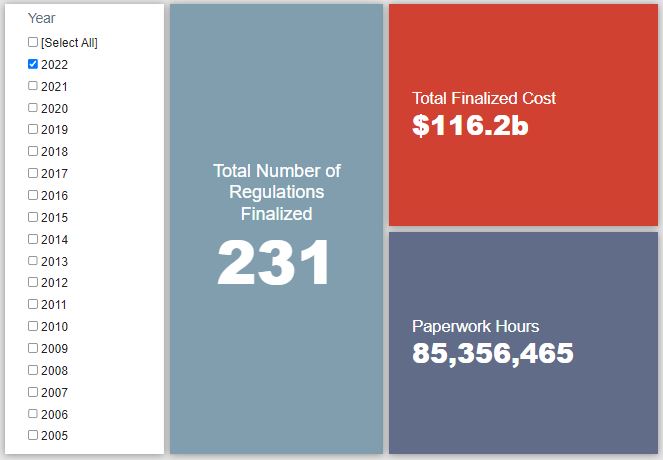Week in Regulation
November 28, 2022
A Thanksgiving Feast of Rulemakings
Despite the short week due to the Thanksgiving holiday, there was plenty to gobble up in the pages of the Federal Register. There were 15 rulemakings with some quantifiable economic impact. Multiple rulemakings brought either costs in the billions of dollars or paperwork requirements in the millions of hours. The most prominent rule of the week – in an eerie bit of synergy with such a food-focused holiday – was a Food and Drug Administration (FDA) measure focused on more rigorously tracking the supply lines for food products. Across all rulemakings, agencies published $7.9 billion in total costs and added 17.3 million annual paperwork burden hours.
REGULATORY TOPLINES
- Proposed Rules: 43
- Final Rules: 73
- 2022 Total Pages: 73,229
- 2022 Final Rule Costs: $116.2 billion
- 2022 Proposed Rule Costs: $139.2 billion
NOTABLE REGULATORY ACTIONS
The most consequential rulemaking of the week was the aforementioned FDA rule regarding “Requirements for Additional Traceability Records for Certain Foods.” The rule establishes “additional recordkeeping requirements for persons who manufacture, process, pack, or hold foods the Agency has designated for inclusion on the Food Traceability List,” with the goal of helping FDA more “rapidly and effectively identify recipients of foods to prevent or mitigate foodborne illness outbreaks and address credible threats of serious adverse health consequences or death resulting from foods being adulterated or misbranded.” As one may expect, a new regulatory program covering such a broad array of entities will involve notable costs. FDA estimates total costs of $6 billion (over a 20-year window) and 13.3 million more hours of paperwork each year due to the administrative burdens involved.
The second most costly rule of the week was a Securities and Exchange Commission (SEC) rule regarding “Tailored Shareholder Reports for Mutual Funds and Exchange-Traded Funds; Fee Information in Investment Company Advertisements.” The rule establishes a framework to “require open-end management investment companies to transmit concise and visually engaging annual and semi-annual reports to shareholders that highlight key information that is particularly important for retail investors to assess and monitor their fund investments.” SEC estimates that these new requirements will add nearly 1.5 million hours annually to current paperwork requirements with $473 million in commensurate annual costs (or $1.4 billion total over the 3-year period in which paperwork requirements are officially approved).
TRACKING THE ADMINISTRATIONS
As we have already seen from executive orders and memos, the Biden Administration will surely provide plenty of contrasts with the Trump Administration on the regulatory front. And while there is a general expectation that the current administration will seek to broadly restore Obama-esque regulatory actions, there will also be areas where it charts its own course. Since the AAF RegRodeo data extend back to 2005, it is possible to provide weekly updates on how the top-level trends of President Biden’s regulatory record track with those of his two most recent predecessors. The following table provides the cumulative totals of final rules containing some quantified economic impact from each administration through this point in their respective terms.
![]()
The two rules discussed above provided the bulk of the spikes in final rule costs and paperwork for the Biden Administration. With $7.7 billion more in the former column and a 14.7 million increase in the latter, the Biden Administration continues to pace the field by a wide margin in both metrics. The gap between it and the Trump Administration grew wider due to cost-cutting measures published in late November 2018. The most prominent of those was a Medicare payment rule that included notable time savings for certain documentation requirements. The Obama Administration, however, saw relatively more modest shifts, with the most significant change being a 1.2 million spike in paperwork from its own 2010 Medicare payment rule.
THIS WEEK’S REGULATORY PICTURE
This week, the Federal Aviation Administration (FAA) requires medical certificates for certain hot air balloon operators.

On November 22, the FAA published a final rule in the Federal Register titled “Medical Certification Standards for Commercial Balloon Operations.” The rule removes an exemption for commercial hot air balloon operators from a requirement to have a second-class medical certificate, which currently applies to pilots. The FAA requires pilots to have their fitness examined by an FAA-authorized medical examiner. Hot air balloon operators were previously exempted but will now be required to have a certificate when operating balloons for commercial purposes.
The impetus for the rule was a 2016 incident in Texas, where a balloon struck power lines and caught fire, killing 15 passengers and the pilot. The National Transportation Safety Board – the federal agency that investigates such incidents – recommended that the FAA require commercial balloon operators to have medical certificates after it determined that the pilot’s lack of medical fitness was a major factor in the tragedy.
Congress also stepped in. In a 2018 reauthorization of the FAA, it required the agency to hold balloon operators to the same medical certification standards as “a pilot flightcrew member of other aircraft.”
Despite specific direction from Congress, about 70 percent of public commenters on the proposed rule opposed the action. Most commenters thought that the rule’s application was overly broad. Those commenters recommended setting a threshold of a certain number of passengers over which the rule would apply. They expressed that the cost was burdensome for smaller operators and the incident that led to the rule occurred at a larger operator. The FAA rejected this assertion and believed that Congress did not grant the agency the latitude to create a carveout for small operators.
The FAA estimates the total cost of the rule at $6.9 million over the next 10 years, though costs could be as high as $16.3 million depending on the number of operators that need certification.
TOTAL BURDENS
Since January 1, the federal government has published $255.4 billion in total net costs (with $116.2 billion in new costs from finalized rules) and 168.3 million hours of net annual paperwork burden increases (with 85.4 million hours in increases from final rules).












